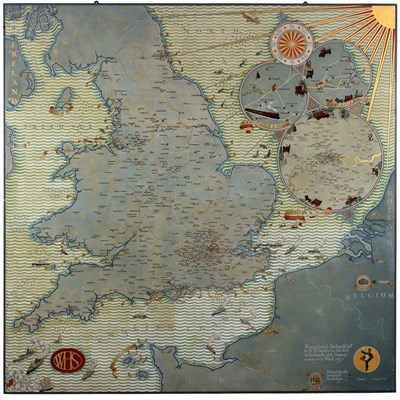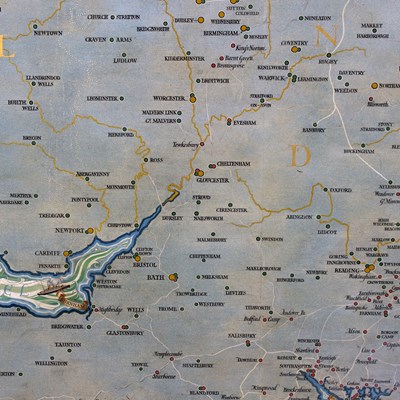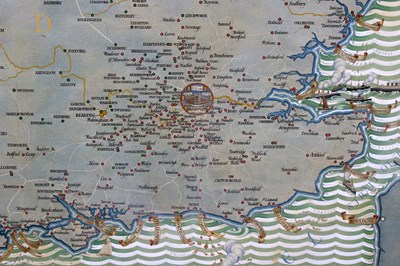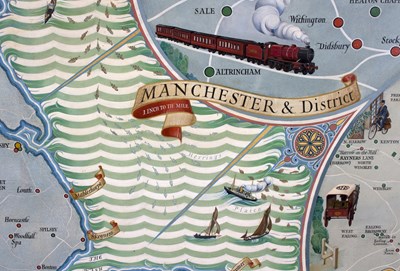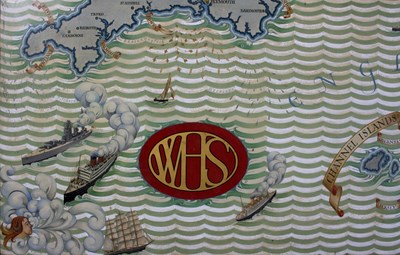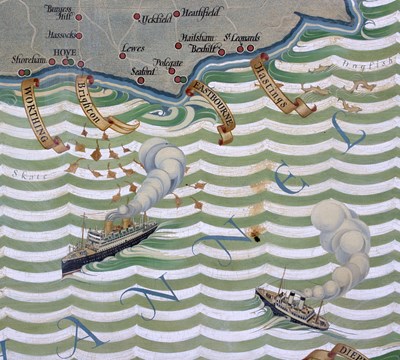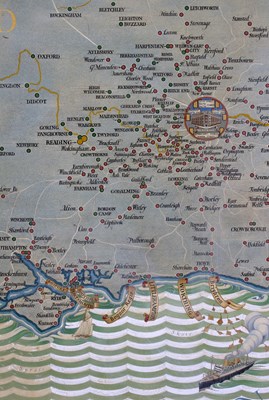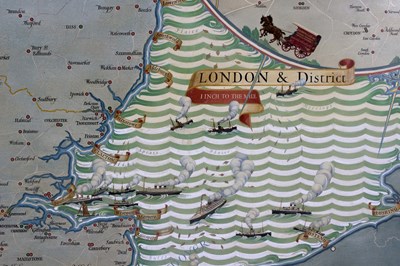16th Apr, 2019 10:00
Modern Art & Design
149
MacDonald Gill (British 1884-1947)/A Map of England, Wales and Northern Europe/showing all the branches of WHSmith existing on 31 March 1931/scale 1in. to 1 mile/oil on panel, 210cm x 211cm/ Note: Born in Brighton in 1884, MacDonald 'Max' Gill (1884-1947), brother of the sculptor Eric Gill, became one of the leading graphic designers of his age. Although best known to the public for his entertaining pictorial poster maps, he was also an architect, letterer and mural painter. After joining a leading London architectural firm in 1903, he enrolled in calligraphy at the Central School of Arts & Crafts where his tutor was the legendary Edward Johnston. Beautiful lettering became an integral element in all his work. Gill set up his own studio in 1908, undertaking calligraphy, inscription design and mural painting. The following year he was commissioned by the Arts & Crafts architect Sir Edwin Lutyens to paint the first of a series of decorative panel maps for the houses of wealthy Edwardians. These came to the attention of Frank Pick, the Commercial Manager of the Underground Electric Railways of London (now London Underground), who asked Gill to create an eye-catching pictorial poster to amuse passengers as they waited for their trains. Published in 1914, the Wonderground Map of London Town caused people to 'watch so long they miss their trains yet go on smiling'. At the end of 1917 - while Max Gill was in Dorset working as architect on a model farm project - he was invited onto the headstone committee of the Imperial War Graves Commission. The alphabet and regimental badge he designed for the military headstone are still used today - perhaps his most enduring legacy. In the inter-war period Gill painted map panels for many notable firms and public institutions including Sun Engraving, Cunard, the University of London and the House of Commons. The W.H. Smith map was commissioned in 1929 by the firm's chairman Charles H. St. John Hornby and director Arnold D. Power soon after W.H. Smith had become a private company - and reflects the company's illustrious heritage as the number one stationer on British high streets. As well as the bookstalls and branches, it depicts the range of newspaper delivery methods - old and new - used by the firm. An Englishman in Paris could buy his daily paper at the W.H. Smith branch on the Rue de Rivoli - also shown on the map. Perhaps he travelled there on the aircraft The City of Glasgow, depicted over the Channel, which was the first luxury London to Paris service operated by Imperial Airways. The panel was installed in the W.H. Smith boardroom in the autumn of 1931. According to Gill's ledger, he was paid £765 - around £42,000 in today's money - a small fortune. Max Gill died in 1947 and was survived by his second wife, Priscilla (née Johnston). The collection of artworks and memorabilia she saved has been displayed in a series of exhibitions around the country in recent years and led to a dramatic upsurge in interest from collectors as well as the general public./ Copyright: Caroline M Walker, great-niece of MacDonald Gill, biographer and archivist: www.macdonaldgill.com <http://www.macdonaldgill.com> / Caroline Walker is the great-niece of MacDonald Gill. She has compiled his biography and hosts a website devoted to his work: macdonaldgill.com. Our thanks to Caroline for this introduction.
Sold for £50,000
MacDonald Gill (British 1884-1947)/A Map of England, Wales and Northern Europe/showing all the branches of WHSmith existing on 31 March 1931/scale 1in. to 1 mile/oil on panel, 210cm x 211cm/ Note: Born in Brighton in 1884, MacDonald 'Max' Gill (1884-1947), brother of the sculptor Eric Gill, became one of the leading graphic designers of his age. Although best known to the public for his entertaining pictorial poster maps, he was also an architect, letterer and mural painter. After joining a leading London architectural firm in 1903, he enrolled in calligraphy at the Central School of Arts & Crafts where his tutor was the legendary Edward Johnston. Beautiful lettering became an integral element in all his work. Gill set up his own studio in 1908, undertaking calligraphy, inscription design and mural painting. The following year he was commissioned by the Arts & Crafts architect Sir Edwin Lutyens to paint the first of a series of decorative panel maps for the houses of wealthy Edwardians. These came to the attention of Frank Pick, the Commercial Manager of the Underground Electric Railways of London (now London Underground), who asked Gill to create an eye-catching pictorial poster to amuse passengers as they waited for their trains. Published in 1914, the Wonderground Map of London Town caused people to 'watch so long they miss their trains yet go on smiling'. At the end of 1917 - while Max Gill was in Dorset working as architect on a model farm project - he was invited onto the headstone committee of the Imperial War Graves Commission. The alphabet and regimental badge he designed for the military headstone are still used today - perhaps his most enduring legacy. In the inter-war period Gill painted map panels for many notable firms and public institutions including Sun Engraving, Cunard, the University of London and the House of Commons. The W.H. Smith map was commissioned in 1929 by the firm's chairman Charles H. St. John Hornby and director Arnold D. Power soon after W.H. Smith had become a private company - and reflects the company's illustrious heritage as the number one stationer on British high streets. As well as the bookstalls and branches, it depicts the range of newspaper delivery methods - old and new - used by the firm. An Englishman in Paris could buy his daily paper at the W.H. Smith branch on the Rue de Rivoli - also shown on the map. Perhaps he travelled there on the aircraft The City of Glasgow, depicted over the Channel, which was the first luxury London to Paris service operated by Imperial Airways. The panel was installed in the W.H. Smith boardroom in the autumn of 1931. According to Gill's ledger, he was paid £765 - around £42,000 in today's money - a small fortune. Max Gill died in 1947 and was survived by his second wife, Priscilla (née Johnston). The collection of artworks and memorabilia she saved has been displayed in a series of exhibitions around the country in recent years and led to a dramatic upsurge in interest from collectors as well as the general public./ Copyright: Caroline M Walker, great-niece of MacDonald Gill, biographer and archivist: www.macdonaldgill.com <http://www.macdonaldgill.com> / Caroline Walker is the great-niece of MacDonald Gill. She has compiled his biography and hosts a website devoted to his work: macdonaldgill.com. Our thanks to Caroline for this introduction.
Auction: Modern Art & Design, 16th Apr, 2019
